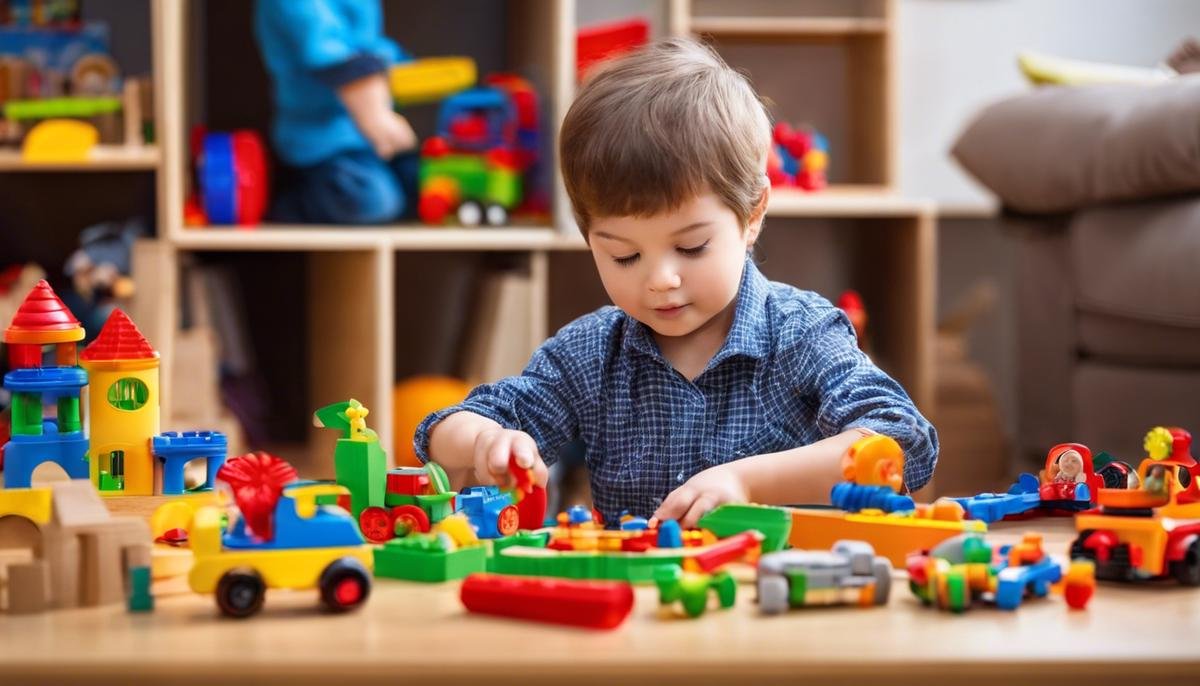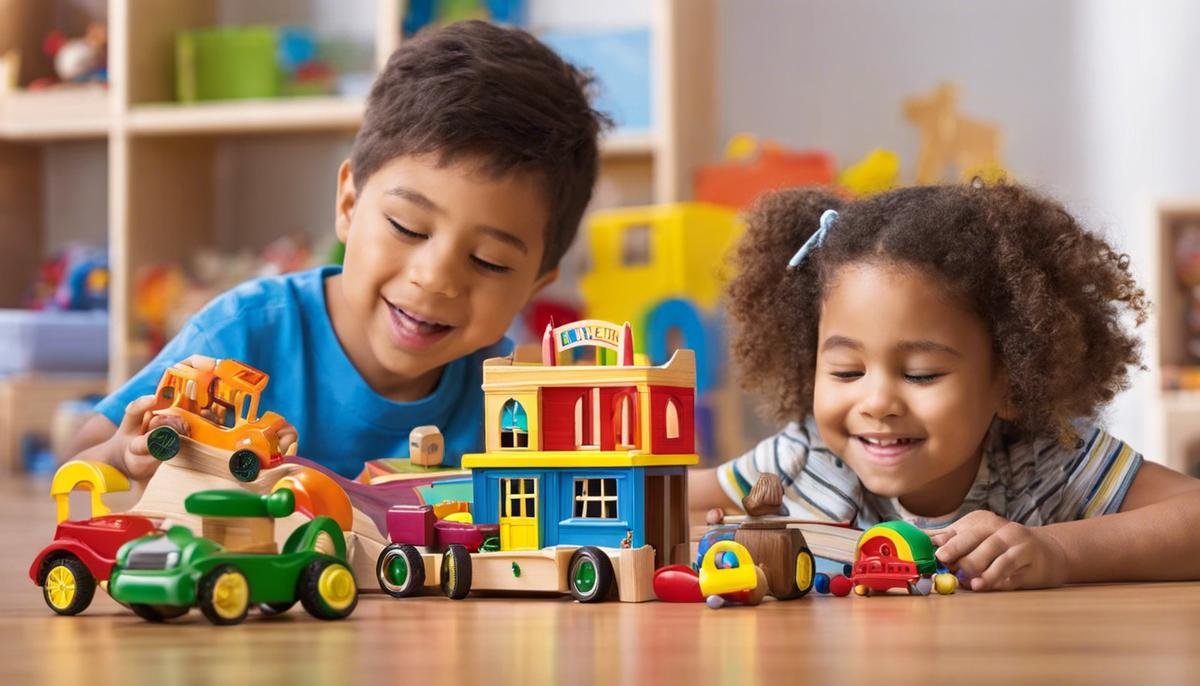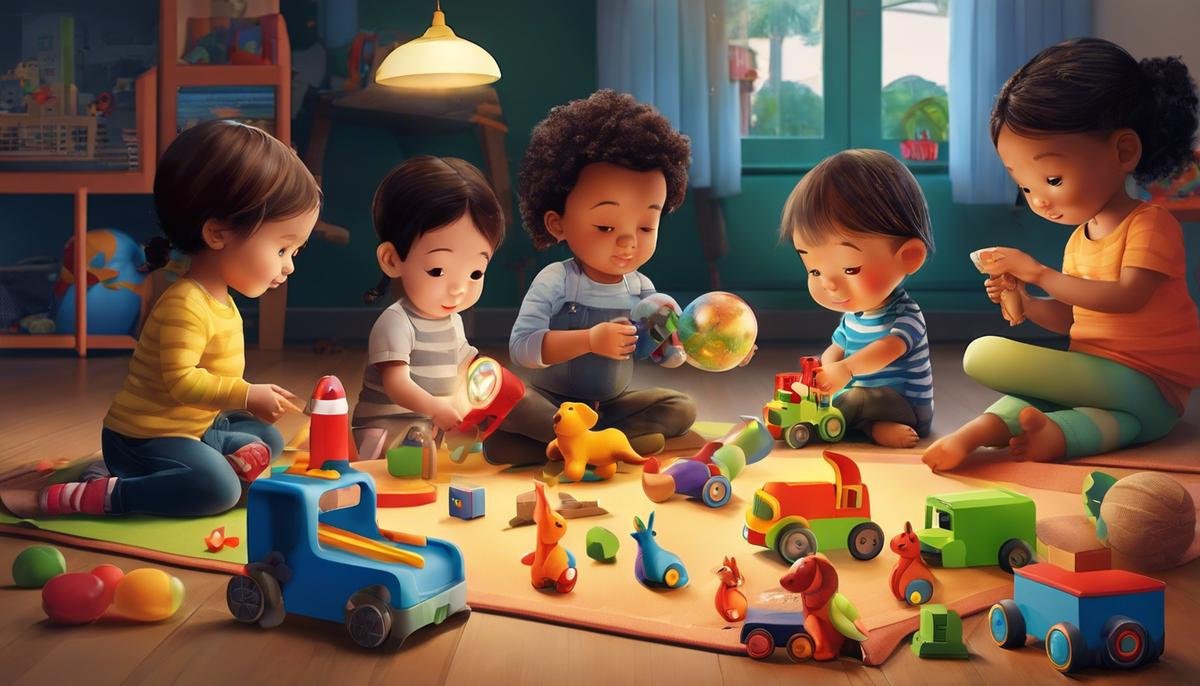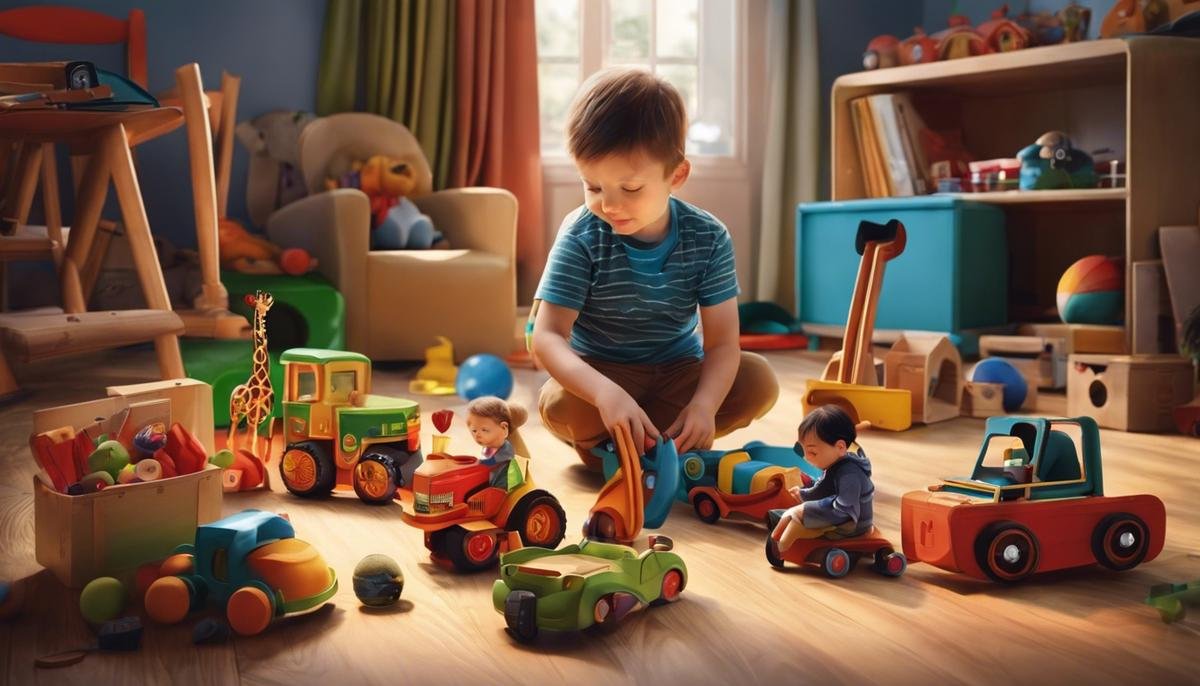
Entering into the world of an autistic child often requires special keys – keys that unlock the doors of communication, development, and connection. One of the most vital keys in this context is toys. Seen as merely playthings by many, toys play an imperative role in the lives of children with autism. Beyond providing entertainment and fun, they effectively stimulate various developmental aspects that are often challenging for these kids. From fostering sensory processing capabilities to nurturing language and social-emotional skills, toys do a phenomenal job. Choosing the right one considering the child’s interests and abilities further offers potential therapeutic benefits. Even more so, it presents a wonderful opportunity for parents to connect deeply with their children.
The Role of Toys in Autistic Child’s Development
The Cherished Role of Toys in An Autistic Child’s Development
Isn’t it incredible how a child’s world revolves around toys and play? As parents and caregivers, we’ve all watched our children huddled in a corner, totally engrossed in a whirl of dolls, cars, or building blocks. Besides being sources of fun, toys are instrumental in promoting toddlers’ cognitive, motor, and socio-emotional faculties. For children with Autism Spectrum Disorder (ASD), the impact of play and toys extends further to become an essential therapy tool, reinforcing learning and development skills.
Let’s explore this fascinating journey of how toys aid an autistic child’s development.
- Promoting Social Skills
- Facilitating Communication and Language Development
- Improving Fine and Gross Motor Skills
- Aiding Sensory Processing
- Encouraging Imagination
- Building Independence
Interestingly, when used correctly, toys can play a significant role in enhancing an autistic child’s social capabilities. Think about board games that encourage turn-taking or role-playing with dolls and action figures; these activities significantly help your child understand nuances of human interaction.
Toys can also function as vital tools in fostering communication and language skills in autistic children. For instance, picture cards, flashcards, or storybooks offer a visual context that enhances understanding and encourages language use.
A variety of toys and play activities can aid in enhancing both fine and gross motor skills. From holding a crayon to play catch with a soft ball or balance on a hopper ball, toys are key to physical development.
Autistic children often have unique sensory needs. Sensory toys such as squishy stress balls, fidget spinners, or toys with different textures can provide the right amount of sensory input to help your child self-regulate.
While children with ASD can face challenges with imaginative play, certain toys can help stimulate this important skill. Toys that aren’t too prescriptive, such as blocks or pretend play sets, can encourage autistic children to create narratives and scenarios, fostering creativity.
Finally, several toys and games aid in developing independence. Simple puzzles or LEGO sets that your kid can solve or build, step by step, can instill a sense of achievement, boosting confidence and self-reliance.
In the delightful world of playthings, one size surely does not fit all. Knowing your child’s interests and tendencies is crucial to choose the right toys to aid their development. Remember, though, to allow your child to guide the play. This will ensure they stay engaged, have fun, and, most importantly, learn from their playtime.
Toys are indeed magical learning tools, and in the hands of our little ones, they whisper beautiful life lessons. So, let your kiddo dive into their world of toys and play, nurturing their growth one toy at a time. And as they do, don’t miss any opportunity to join them on the floor for a little fun because remember, we’re all kids at heart.

Choosing the Right Toys for Autistic Children
The Ultimate Guide to Choosing Toys for Children with Autism
Navigating the large selection of toys available today can be overwhelming for any parent. However, for those with children on the autism spectrum, this task can be even more daunting. Here’s a comprehensive guide on important elements to consider when picking out toys for autistic children, beyond the typical considerations of promoting social skills, facilitating communication, fostering improved fine and gross motor skills, aiding in sensory processing, encouraging imagination, and building independence.
- Safety: The cardinal rule for choosing any child’s toy is safety. This is especially crucial for children with autism, as they often engage in repetitive motions or ‘stimming’ that could unfairly wear down certain toys. Ensure that the toys you end up selecting are robust, with no small parts that may be a choking hazard, and are crafted with non-toxic materials.
- Interests and skills: It’s essential to have a clear understanding of your child’s current skills and fascinations. Aim for toys that align with these. For instance, if your child has a laser-sharp focus on puzzles, consider variations of these that can subtly challenge them and enhance their cognitive abilities.
- Durability: Toys for autistic children should be durable and hold up well to intense use. Some youngsters may have stimming behaviors related to obsessive-compulsive tendencies, so the toys you provide should be able to withstand frequent use.
- Adaptability: Look for toys that can be adapted or expanded as your child grows and their skills develop. For example, blocks and LEGO sets can be utilized in more advanced ways as your child’s abilities progress.
- Social Interaction: Toys that facilitate social interaction and reciprocal play are especially beneficial for autistic children, even beyond the basic promotion of social skills. Board games that require multiple players or interactive pretend play toys can encourage your child to socialize with their siblings or peers.
When selecting toys for a child with autism, it’s essential not to view this task as a chore but rather as an opportunity to select tools that will enhance your child’s growth, development, and importantly, joy. Is there a surefire recipe for the perfect toy? Perhaps not! But with careful consideration of these factors, you could definitely make well-informed decisions about which toys will provide the most beneficial and enjoyable experiences for your child.

Therapeutic Benefits of Toys
How Toys Bolster Self-Esteem, and Boost Emotional IQ in Children on the Autism Spectrum
While addressing the practical benefits that toys can provide for children on the autism spectrum, such as improving motor skills and language development, it is essential to also highlight their role in supporting emotional growth. Toys can significantly contribute to the bolstering of self-esteem and boosting of emotional intelligence, two aspects that can sometimes present a challenge for a child on the autism spectrum.
Toys can be a powerful tool for building self-esteem. A child on the spectrum who successfully completes a puzzle, figures out a complex building block, or achieves a new milestone with any toy experiences a burst of pride and self-accomplishment. These feelings of achievement can go a long way in fostering their overall sense of self-worth.
Concerning emotional intelligence, many toys are designed to help children recognize and understand various emotions. Dolls with different facial expressions or board games that involve emotive scenarios can help a child on the spectrum connect different feelings with specific situations. This understanding can prove invaluable in their day-to-day interactions and help them to better navigate their emotional landscape.
With these benefits, it’s essential to always approach the selection of toys with an open mind. What might seem a perfect fit might not resonate with the child’s unique interests, so a trial-and-error process can sometimes be needed. Some children might gravitate more towards sensory toys, while others would rather engage with ones that stimulate their imagination or creativity.
An additional factor that might bear importance in the toy selection process might be to seek toys that encourage interaction with others. This feature can contribute to the development of social skills, as the child learns about the fun inherent in sharing and cooperating with peers or family members.
Toys can serve more than their fair share of therapeutic benefits in relation to children on the autism spectrum, promoting important life skills. When selecting toys, always consider not only the practical benefits but also the potential for emotional and psychological growth.
Ultimately, the goal is to foster a supportive and fun environment that allows children to experience the wholly enriching and enjoyable aspects of childhood, irrespective of their differences. The right selection of toys can make a whole world of difference in this endeavor.

Toys and Communication Skills
Why Toys are Indispensable Tools in Boosting Communication Skills
Did you know that toys are not just an integral part of a child’s playtime fun but also an important learning and development tool? That’s right! Toys play a central role in fostering the development of communication skills, particularly for children with unique autistic traits. But how exactly do these fun elements help the little ones become proficient communicators?
Toys, particularly when incorporated in a structure of play, help children create dialogues either verbally or non-verbally. As children engage in pretend play with dolls or action figures, they begin to take on different roles, mimicking real-life interactions and conversations. Playing with toys that relay cause and effect relations such as push-and-pull toys can foster a child’s associative thought process, an important prerequisite for communication.
Diverse toys help in emblematic and representational play. When children manipulate objects like building blocks, play dough, or craft toys like crayons and string beads, they’re expressing thoughts and ideas through creativity, thereby facilitating non-verbal communication. Such activities also enable children to build visual perception skills, which are crucial in recognizing and interpreting cues during non-verbal communication.
Games with rules are also an excellent resource to improve kids’ communication. Board games, card games, and even some video games require players to speak, listen, and follow instructions, all of which are fundamental communication skills. Similarly, pairing toys with books can be a beneficial strategy. As children listen to the story and play with the matching toy, they enhance their language comprehension ability while associating words with actions or objects.
Remember, the path to sufficiently engaging autistic children often calls for picking toys that resonate with the child’s individuality. Some children may show significant progress with light-up toys that stimulate visual communication, while others might do better with toys that replicate real-world objects to build context-based communication.
Moreover, the use of toys in communication skill development proves to be equally fruitful in building emotional communication. Various emotional-themed toys like mood charts, emotion masks, or dolls with different facial expressions can help kids identify and express feelings – a key ability in effective communication.
Finally, group games like a round of tag or a friendly soccer match incite communication and compel children to develop the art of strategic communication in an enjoyable manner. Coordinating with teammates, deciding game strategies, and cheering each other on are all real-world communication scenarios presented in a more relaxed manner.
In a nutshell, remember that the core principle here is to create a balanced toy ecology. This mix of active toys, toys for creative thinking and learning, and toys that promote emotional and social interaction can enormously enhance communication skills in children, especially those carrying charismatic autistic traits. A wisely picked toy set can become a playground of skill-building opportunities for your little ones, helping them to thrive in communication.
Contributing to this enriching journey from simple baby babble to coherent talk, toys are indeed essential in nurturing a child’s communication abilities. So, next time you’re selecting a toy, remember it’s not just about fun, but also about opening up a world of learning and development!

Connecting through Play
Nurturing Emotional Resilience through Toys
Toys go far beyond just being playthings for children. Especially for children on the autism spectrum, they can be powerful tools for emotional development and bonding. Cultivating emotional resilience in an autistic child can be a challenge, but working with toys, these challenges can turn into tangible growth and flourishing relationships.
Puppets or dolls can play an invaluable part in helping your child understand emotions better. When used to enact different scenarios, they can help model various emotional states, responses, and resolutions. Using a comfortable medium through toys can make this learning more pleasing and enjoyable.
Another important aspect is the introduction of toys that require team play. Such toys not only help autistic children understand the significance of collaboration but also make them appreciate the joy of shared achievement. This proactive approach can lead to a more robust emotional bond between the child and the parent, as you participate and win together.
When choosing toys for your autistic child, keeping in mind their unique abilities, interests, and skills can help in selecting the right ones. For instance, if your child loves music, musical toys could be an excellent way to connect. If they enjoy being outdoors, a kite or a ball can bond you two together while supporting emotional growth.
Further, toys like legos, building blocks, or complex jigsaw puzzles can serve a dual purpose. They enhance focus and perseverance, and when completed, boost self-esteem. For an autistic child, the accomplishment can be a great motivator and mood enhancer, thus building emotional resilience.
Story-oriented or make-believe toys are another great selection. They can serve as a platform for you to converse and connect better with the child. They allow kids the freedom to craft their narratives, helping them to express their feelings and thoughts better. As a parent, listening to these stories and participating in their imaginative play can aid you in understanding your child’s emotional world better, thus strengthening the bond.
To sum up, toys are more than just plastic and shine; they can become a gateway into your child’s emotional landscape. They provide an engaging, exciting way to build resilience, all the while strengthening the bond with your little one. By selecting the right toys and optimally utilizing them, the journey of raising an autistic child can become a meaningful and closer-knit one for everyone involved. Happy playing!

Ultimately, the role of toys in an autistic child’s life is multifaceted and profound. From developmentally beneficial playthings to therapeutic aids and communication enhancers, they greatly help in shaping the child’s abilities. Furthermore, understanding and engaging with your child’s play can often shine a spotlight on their world, revealing their thoughts, struggles, and victories. By selecting the right toy aligned with their interests and the level of development, parents are capable of providing immense support for their children, while also cultivating a strong bond grounded in empathy and understanding. As we navigate through the journey of autism, these aids minutes become not just toys, but bridges to understanding, development, and closer connection.




